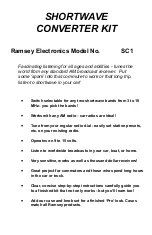
C1.2 User Manual
28
More generally, when a C1.2 has no SYNC-I/O board, it can only clock itself to the incoming audio stream (clock
source is AUDIO IN) when playing a CH-Link HD, AES EBU, COAXIAL or OPTICAL input.
D1.5 clock source: INTERNAL
C1.2 clock source (for this input): AUDIO IN
If in this configuration (clock source = AUDIO IN) the C1.2 is unable to lock (open padlock) on an incoming S/PDIF
audio stream but properly detects its sampling frequency (a valid Fs is displayed instead of “Fs UNKNOWN” in the
upper left corner of its display), it probably means that the S/PDIF source does not comply with AES standards
and/or has too much jitter. To overcome this problem, set the clock source as Sample Rate Convertor (SRC) for this
input. It will add an asynchronous sample rate conversion stage that has a wider locking range.
7.3 C1.2 DAC/Controller (with SYNC-I/O board) + D1.5 or D1 CD/SACD transport
(with SYNC-I/O board)
When both the C1.2 and the D1.5/D1 are equipped with a SYNC-I/O board, optimum performance is obtained when
the C1.2 DAC is the clock master, and the D1.5/D1 transport is the clock slave. The audio stream goes from the D1.5/
D1 to the C1.2, but the clock signal goes the other way. The schematic below shows how to connect such a system:
When paired with a D1 or D1.5 player (equipped with both Digital and Analog outputs) recommended setup is still
the same (i.e. the clock signal goes from the C1.2 to the D1.5/D1). In such a case:
D1.5/D1 clock source: SYNCHRO BNC 75
Ω
C1.2 clock source (for this input): INTERNAL
AC input
AC input
Ground link
Ground link
BNC clock cable
CH LINK HD
D1.5
C1.2
Simple D1.5 - C1.2
connection













































